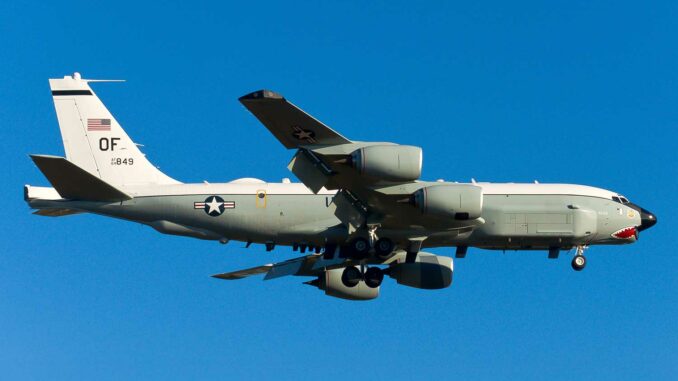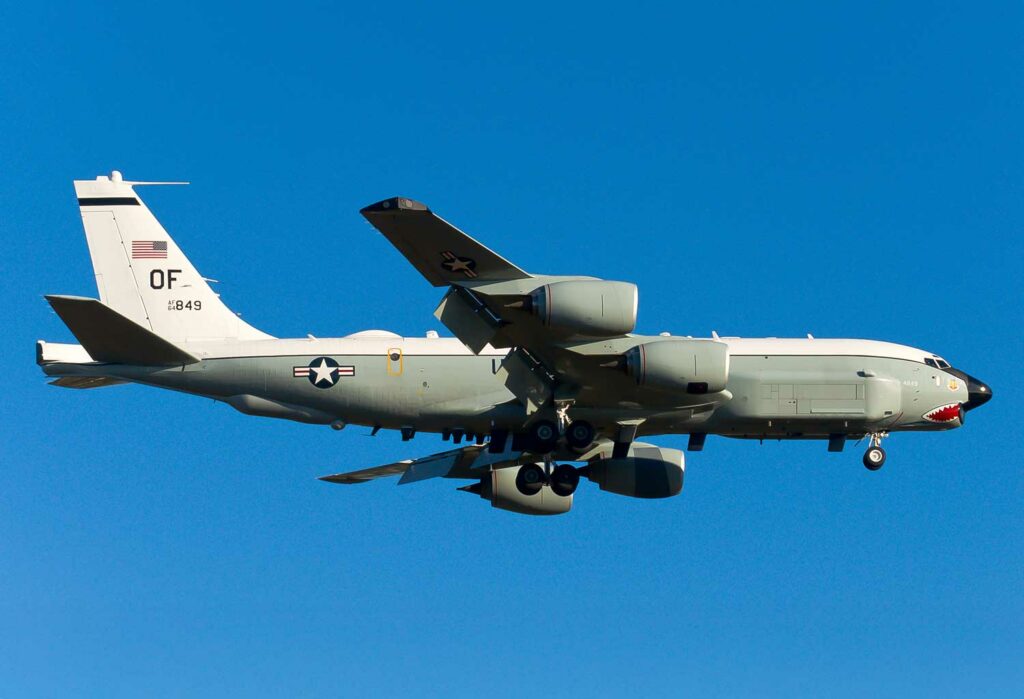
A US RC-135U reconnaissance aircraft, taking off from RAF Mildenhall, was spotted conducting a surveillance mission around Kaliningrad, heightening tensions in the region.
Summary
An American RC-135U Combat Sent spy plane, based at RAF Mildenhall (Suffolk, United Kingdom), was observed flying over and circling areas close to Russia, notably the enclave of Kaliningrad, before returning to base after a mission lasting around 7 hours. The aircraft, which specializes in signals intelligence, carried sophisticated equipment to locate, analyze, and catalog Russian radar and communications emissions. Thanks to its in-flight refueling capability, this platform can operate remotely for very long periods of time. This mission comes amid tensions between NATO and Russia, where aerial and electronic surveillance plays a key strategic role in deterrence.
The observed mission and its key elements
Takeoff and flight path
According to tracking data (FlightRadar24) reported by the media, the RC-135U took off from RAF Mildenhall at around 02:32 (local time) and landed at 09:36, completing a mission lasting just over 7 hours. It appears to have flown over the Baltic Sea and circled the Russian enclave of Kaliningrad before returning to Great Britain. The same aircraft had already been seen on October 2 in a similar pattern: departure from the United Kingdom, transit via the Baltic States, surveillance zone near Kaliningrad, return.
The reconnaissance flight focused on strategic points: border areas, maritime corridors, and potential coastal or military radars. This profile is typical of a SIGINT/ELINT (electromagnetic intelligence) mission, aimed at capturing Russian radar emissions, command signals, or communication frequencies.
The RC-135U platform: capabilities and role
The RC-135U Combat Sent is a specialized version of the RC-135 family, dedicated to surveillance of enemy radar and communication emissions. The aircraft is equipped with passive sensors, directional antennas (particularly under the fuselage and at the wing tips), and a signal interception system. It works in coordination with intelligence analysis centers to provide decision-makers with detailed reports on enemy radar capabilities.
Thanks to its architecture, the aircraft can remain in flight for long periods of time, supported by aerial refueling. This gives it virtually unlimited range, as long as refueling aircraft (KC-135, KC-46, or others) are available. Its typical crew includes pilots, navigators, systems engineers, radio/frequency operators, and analysts.
The geostrategic stakes of the mission
Surveillance and power projection
The mission reflects the strategic use of advanced aerial reconnaissance in a context of implicit confrontation between NATO and Russia. By flying over areas near Kaliningrad, the USAF gathers information on coastal radar networks, Russian military transmissions, and the defense posture of this strategic enclave.
The enclave of Kaliningrad is particularly sensitive: located between Poland and Lithuania, it houses ballistic capabilities, Sever anti-aircraft radars, and constitutes a Russian bridgehead in the Baltic Sea. Monitoring its emissions allows NATO to calibrate its own radar penetration, jamming, or strike plans in the event of conflict.
Diplomatic message and deterrence posture
A flight like this goes beyond simple intelligence gathering: it sends a political signal. It demonstrates the willingness of the US and its allies not to back down in Russia’s backyard, even in the Baltic Sea. In times of hybrid warfare, this type of operation contributes to the deterrence posture, prompting the adversary to calibrate its responses.
The mission also comes at a time of heightened tension: Germany recently denounced Russia’s “hybrid warfare,” particularly through spy drones flying over infrastructure. This type of aerial espionage flight intensifies mutual surveillance and technological competition between powers.
Technical and tactical constraints
Detection risks and countermeasures
An aircraft such as the RC-135U operates in a contested area, where Russian air defenses can activate their radars, surface-to-air missiles, or interception systems. To reduce the risk, the aircraft stays outside the densest radar “bubble,” uses peripheral flight paths, and may resort to electronic self-protection measures (jamming, passive collection, signature masking).
However, the signals picked up can be used as decoys to attract fire or trigger Russian countermeasures, forcing the aircraft to fly cautiously. The fact that it circles in the area along Kaliningrad suggests a methodical positioning to pick up long-range radar beams rather than exposing itself directly to nearby defenses.
Logistics and refueling
To maintain extended flight time, the RC-135U relies on in-flight refueling. The choice of RAF Mildenhall, which is home to refueling units (100th Air Refueling Wing), facilitates this coordination. The refueling aircraft connects to the spy plane via a boom or hose in flight, while the two aircraft maintain a stable formation.
This synergy requires precise planning: rendezvous times, authorized air corridors, flight clearances in naval or international zones. Any error could expose the tanker or spy plane to danger or compromise the mission.
Data and communication management
The central element of a SIGINT mission is the capture, filtering, encoding, and transmission of data to analysis centers. The RC-135U has secure data links (satellite or tropospheric link), allowing segments of transmissions to be sent to listening posts in near real time. This data is shared with NATO allies, notably the German and British intelligence agencies.
In addition, the aircraft must manage the energy consumption of the sensors, the cooling of the electronic modules (under heavy load), and possible disturbances related to the hostile electromagnetic environment.

Reactions and implications
Expected Russian responses
Moscow could interpret this flight as a provocation or intrusion. In response, Russian aircraft (MiG-31, Su-35) could take off to intercept or escort the “unwanted” aircraft. Long-range anti-aircraft systems (S-400) can monitor the mission via radar beyond the horizon.
Russia could also issue a diplomatic protest, accuse the aircraft of violating national airspace, or conduct defiant aerial maneuvers. Based on previous incidents, Russian bombers escorting the spy plane on its flanks or jamming its sensors are common responses.
The effect on the allied posture
For NATO, this flight illustrates the overflight and intelligence gathering capabilities of its air assets. It strengthens interoperability between the United States, the United Kingdom, and the Baltic states. These missions alter the balance of surveillance in the Baltic Sea and give allies a better understanding of Russian radar architecture.
They complement ISR (intelligence, surveillance, reconnaissance) missions carried out by drones, satellites, and maritime patrol aircraft. The integration of data into NATO fusion centers improves defensive and offensive planning.
Limitations, challenges, and precautions
The risk of escalation
In an already tense climate, such missions could be misinterpreted, cause air incidents, or trigger military reactions. The slightest clash—collision or radar lock—could lead to a serious diplomatic incident.
Russian technological coverage
Russia has advanced SIGINT/ELINT, electronic warfare (jamming), radar decoy, and low-frequency passive radar capabilities. Spy planes must contend with this sophisticated electronic defense. Some signals are jammed or masked, reducing the quality of the intelligence gathered.
Mission duration and cost
Each hour of flight time for the RC-135U costs tens of thousands of dollars in fuel, maintenance, crew, and logistics. In addition, maintaining the availability of platforms and refueling aircraft represents a regular burden for the U.S. fleet in Europe.
Outlook and strategic significance
This flight highlights the growing importance of electronic warfare and aerial intelligence in modern power relations. In the era of hybrid conflicts and cyberwarfare, the superiority of sensors and data can carry as much weight as conventional forces.
The USAF and its allies continue to assert that they will not back down from Russia’s borders, no matter how close they may be. This type of mission—risky but calculated—is a reminder of how much airspace has become a silent battlefield.
War Wings Daily is an independant magazine.